Interview with Lindsay Hussey
Lindsay Hussey is a textile or fibre artist; her medium is fabric and thread. She was interviewed by Creativity Cluster facilitator Nancy Lane for the Melbourne City University of the Third Age (U3A) course Conversations with Artists on 24 August 2020. Excerpts from the interview follow, as well as photographs of the textile work that Lindsay talks about.
Tell us about your background and how you progressed to the work you’re making now.
I’ve always made things – Mum taught me to knit when I was five, and I learned dressmaking and a little bit of embroidery at school. I was with a non-professional musical theatre group for many years and we made all the costumes, so I became creative with putting this sleeve with that bodice and so on. But mostly I was making from patterns rather than creating originals.
I didn’t go to art school; in fact, I’ve come to ‘art’ relatively recently from an embroidery background. My big turning point came when I went to an exhibition at the Embroiderers Guild of Victoria in the mid-90s. I enjoyed the process of embroidery and the Embroiderers Guild showed me that embroidery is so much more than just pretty flowers. I joined immediately.
After trying a few different techniques, I soon discovered and fell in love with crewel embroidery. Crewel is worked with fine wool thread, which appealed to me, but it was the strange but beautiful flower and leaf designs from the Jacobean period that really attracted me. Even though I’d been drawn to the contemporary work in the exhibition, I ended up specialising in a technique that is 500 years old
One of the aims of the Embroiderers Guild is to keep embroidery techniques alive, and I was able to study crewel embroidery to a very high standard. But as well as teaching the techniques, the Guild encourages members to create their own designs, which I quickly started doing. My work Sacred Waters uses traditional crewel stitching technique, but it is obviously not a traditional crewel design.
If you didn’t go to art school, how did you learn about design?
In 2005 the Guild offered a 9-month course called Art for the Stitch. Run by artist Virginia Mort, the course taught design skills to embroiderers. Learning the formal aspects of design significantly improved my work. The course also introduced me to the vibrant world of contemporary textile art and textile artists who use dye, bleach and paint. They stamp, stencil and print – pretty much anything to achieve the effect they want.
I spent the next few years learning many of these non-embroidery techniques and more about art. I found artists whose work appealed to me and tried to find out how artists make ART. Although I had a bunch of skills and some knowledge of art and design, I needed to find my own style – my artistic voice. I had plenty of inspiration, but I couldn’t create work that satisfied me.
How did you go about developing your personal style?
One day in 2015 I sat down and thought deeply about what I was strongly drawn to and the elements I wanted in my work. I came up with the following list: hand stitching, colour, abstract, layering and texture, and complexity. I now had a focus. About the same time, I found the work of Bozena Wojtaszek on Pinterest and her use of lace resonated with me.
I made some small samples. On a fabric base I put a layer of small pieces of fabric, lace and pieces cut from old doilies which I’d dyed to give variation of tone and colour. I hand stitched these in place. Then, using my crewel thread, I stitched randomly and heavily all over, using stitches that I used more traditionally in crewel embroidery but working them more freely.
The stitching added texture and unified the work, and I was very pleased with the result. So I made a larger piece, Urban Complexity, this time incorporating variegated coloured wool. This technique has been the basis for most of my work since then.
Tell us about the inspiration for some of your works .
Development of this layering technique got interrupted in 2016 when my partner and I went to live in Barcelona for 15 months. I could only take a small amount of textile supplies with me. Unfortunately, I couldn’t continue with my layering technique because I couldn’t dye my fabric and thread. Furthermore, the old doilies that are integral to this work weren’t available in Barcelona.
However, we travelled extensively in Spain and Europe, and what I did get was inspiration and self-discovery. We had the opportunity to see many, many wonderful works of art.
I found that I’m inspired by the built environment – cities, villages, the places people live – rather than by nature. I’m drawn to the patterns made by the juxtaposition of buildings, old stone walls, streetscapes. I was particularly struck by where we humans chose or manage to live: small spaces, inhospitable environments. You’ll find human settlement everywhere.
How did this inspiration get reflected in your work?
We travelled to Morocco and I was inspired by the old cities, the medina. My work Medina of Fez is based on an aerial view of the very, very old medina in the city of Fez. The squares and rectangles in the photo are buildings – homes, work spaces, street stalls. The lines between them are the streets, which are only a couple of metres wide. I wanted to create my impression of the medina, using colour to convey its life and vitality.
Each of the blocks in this work is individually embroidered. Originally I was going to stitch all the small blocks, but I realised the work then wouldn’t have a focal point. Furthermore, the piece was taking hours and hours to complete. Happily, the blocks I’d completed to that point made a balanced design. I finished the work by stitching only the outlines of the remaining blocks.
Back in Australia, I continued to use aerial photos as a starting point. My next work, Metro Velocity, is based on an aerial photo of Los Angeles. This is done using the same layering technique: fabric, lace, then heavy stitching.
What do you feel has been a key learning in your development as an artist?
It has been learning to look; this is essential to an artist. It was critical for me to learn how to really see an object, how to look and really see my surroundings.
For example, I was attracted by the pattern formed by a bank of gas meters. The resulting work, Propane 8, is mainly stitched with large rectangles using my layering technique. I wanted to bring into focus the visually interesting all around us, even on ordinary suburban streets.
Have there been any more recent influences on your work?
In mid-2019 I did a course run by Fibre Arts Australia with American artist, Clarissa Callasen. For each work, Clarissa makes hundreds of small stuffed components. She might wrap or stitch or embellish them in some way. Then she joins them together and mounts them on a wire mesh base. She shapes the base to give extra dimension to the work. After this, she embellishes the work with more stitches or found objects like buttons or shells. She also likes to knot lengths of fabric.
I started to use her technique in some of my work. I already had in mind a piece based on my observations about where people live. Along the shores of Lake Como and the fiords of Norway, there are villages and settlements. They have been built on any narrow strip of flat land along the water with towering mountains behind.
The resulting work is Between the Water and the Mountains. The mountains (green) use my layering technique, but are on a base of shaped wire mesh. The water (blue) is knotted fabric. The buildings are small pieces of wood wrapped in fabric and stitched
I’m not sure about the success of this work. However, I have to try out things to find out what does work and learn from what doesn’t. Just imagining a work won’t tell me if it works.
I created this work, along with another called Between the Oasis and the Desert, for the Creativity Cluster exhibition On the Edge at the Docklands Library. I also showed them at our exhibition Landscapes: Real and Imagined at the Joel Gallery, Altona.
In early 2020, one of your works was selected for the Australian Textile Art Award. Tell us about your entry.
I used Clarissa Callasen’s technique but a different way of working for my entry in the Australian Textile Art Award (ATAA). My partner writes short stories using the method of Robert Olen Butler. His method is to let the writing come from the unconscious – no planning. I thought I would see if this method would translate to my work.
After making a bunch of small fabric modules, I joined them together. I had no image in mind; I just fitted the shapes and colours together. I’d also been playing with joining the different pieces I made with wire.
My original attempt didn’t work out, but I really liked one assembly – the lower assembly of Caught in Flight. This felt to me like flight. I made the top piece to match, then added the swirls of wire to create a feeling of motion. The ATAA exhibition has been postponed, but it can be seen online.
Your works are also in the Creativity Cluster exhibition De-construction/Re-Construction. How have you interpreted this theme?
The construction work disrupting the city is for the new metro rail network. My work, a triptych called Towards a Better …., is based on three rail network diagrams. The first two comprise the existing network and the network including the new tunnel work. The third, a possible future network, shows a ring rail around the suburbs.
There was a particular challenge for me. For the physical exhibition, we each have to fill a large space. Most of my work is less than 30x30cm, but these are 50x50cm. They were too big for hand stitching, so I decided to use machine embroidery.
I deconstructed and reconstructed the city in two ways. First I made a weaving of names of Melbourne streets and landmarks. Next I cut up photos of the city and re-arranged them.
The network maps are machine stitched with reverse applique. The photos and woven strips are printouts transferred onto fabric. To do this, I used gel medium (a thick glue paste) to transfer the printer ink from the paper to the fabric. I machine stitched these to the background and used additional machine stitching as embellishment.
What keeps you motivated and inspired?
I don’t quite know what keeps me motivated, I just know I am. Beautiful and interesting fabrics and colour just light up something in my brain and excite me. I love hand stitching.
I’m never short of inspiration. The idea for a new work gives me a burst of energy. I’m driven to create. I have no problem getting to work, I don’t procrastinate, I grab whatever time I can for making. In fact, I often feel frustrated when other obligations keep me from working.
Does working with textiles have any particular challenges?
One of the big challenges is the time it takes to make a piece. My work Metro Velocity is 20x20cm. It was very straightforward to make. I had all the fabric and thread ready dyed and I wasn’t trying any new techniques. This work took me about 40 hours to make over a 5-week period.
So when I develop an idea, I have to decide whether it’s good enough or has enough value to me to devote the time to make it. This means that lots of bright ideas don’t get further than working out the design. Some ideas I may go back to, but I have too many ideas to be able to physically make them all.
I always hope that whatever I do make will turn out well. However, in order to learn, to push myself as an artist, I need to experiment and see an idea all the way through. I know that some of my pieces are more successful than others. That’s okay; what’s important is working out what worked and what didn’t. Artists have to take risks or they stagnate. And I’m still in the developing stage.
Do you treat art like a job?
Yes and no. Yes, in that I’m serious about improving my work. I invest my time and money in courses, books, research. No, in that I don’t work set hours. I have a studio at home, which means I can grab odd half hours if longer time periods aren’t available.
Can you make a living at art?
I can’t make a living at art; fortunately, I don’t have to. I’m not well enough established and don’t exhibit enough to sell much work. I have thought of making smaller, more saleable items. However, even small items take a lot of time to make, time away from developing my art practice.
Even if I was selling more of my work, I probably couldn’t make a living at it. At the moment I’m pricing my work based on $4 an hour. Unless an artist is very well known, getting a decent hourly rate for textile art is very difficult. Textile art has less status – and therefore less ‘worth’ – than art made with paint. I teach for the Embroiderers Guild from time to time, which gives me a little income, but that’s not regular.
I’m very fortunate that I don’t have to concern myself with making a living. This means I can concentrate on developing my artistic skills.
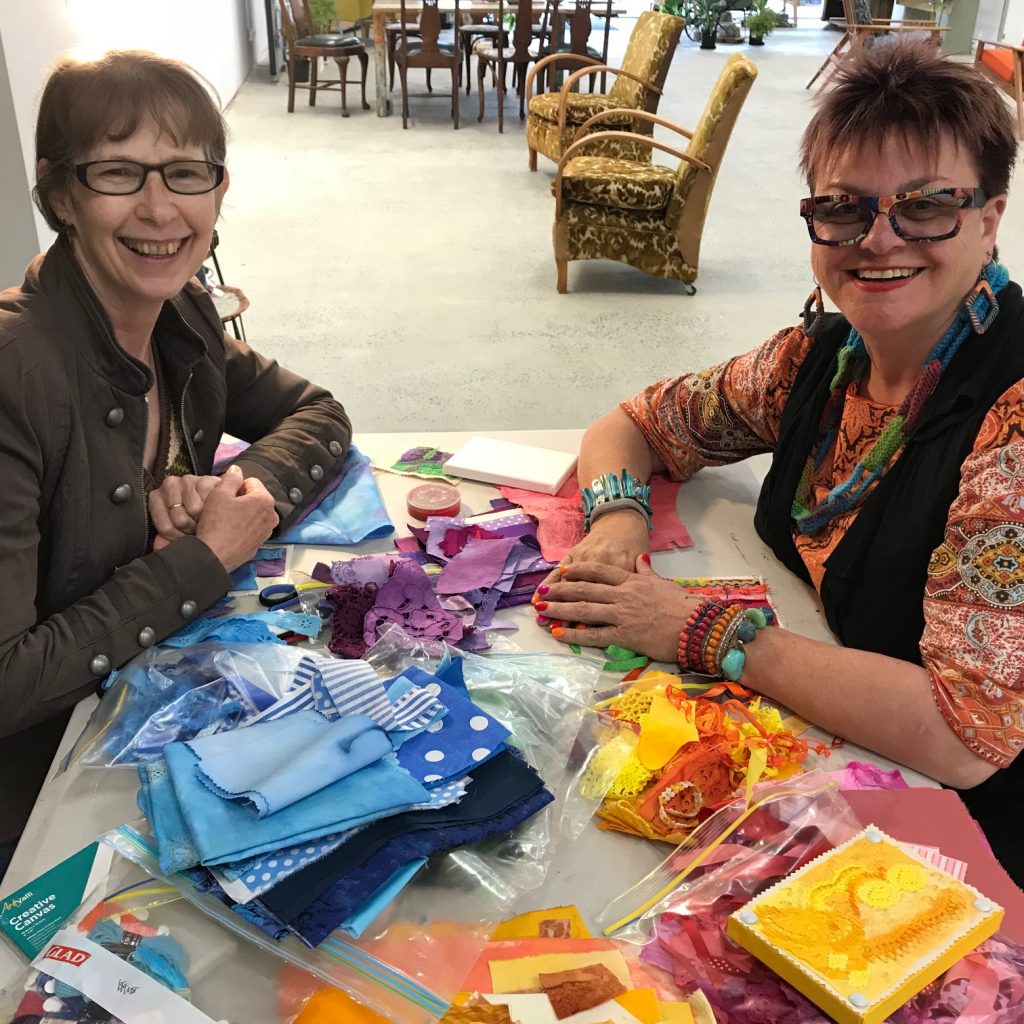
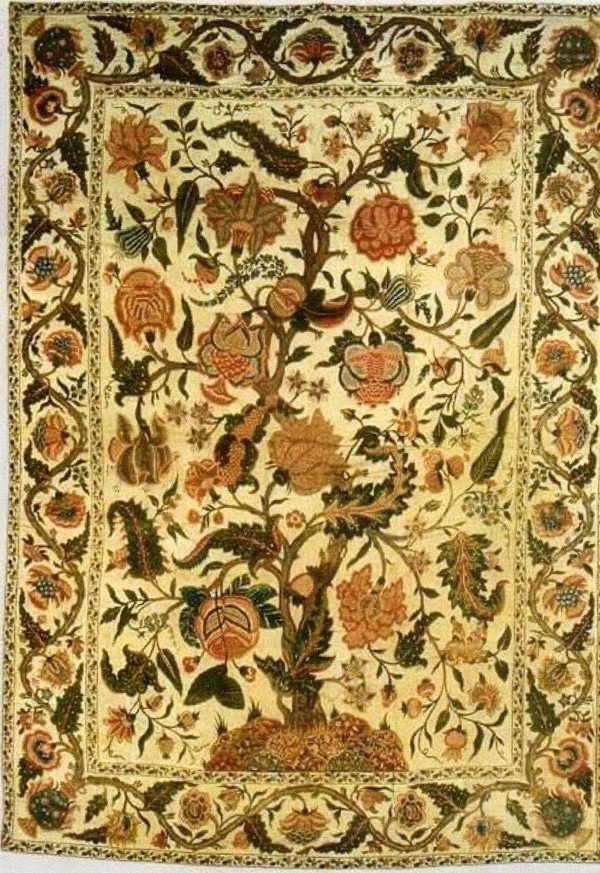
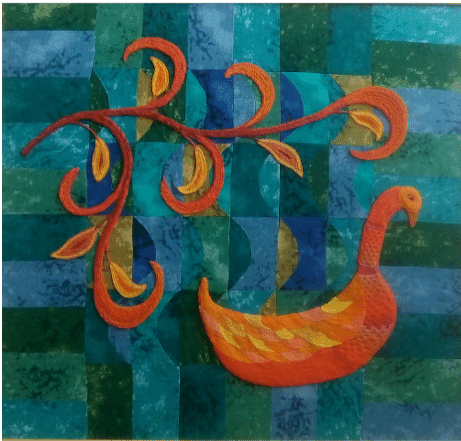
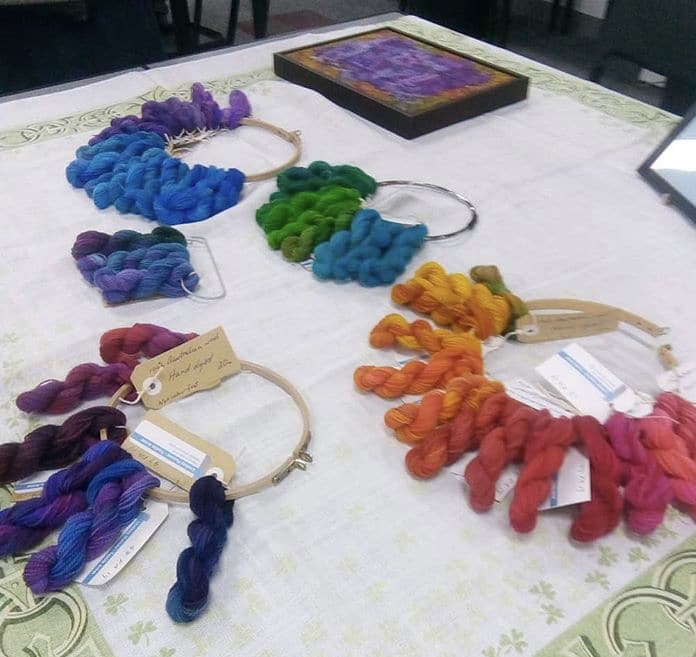

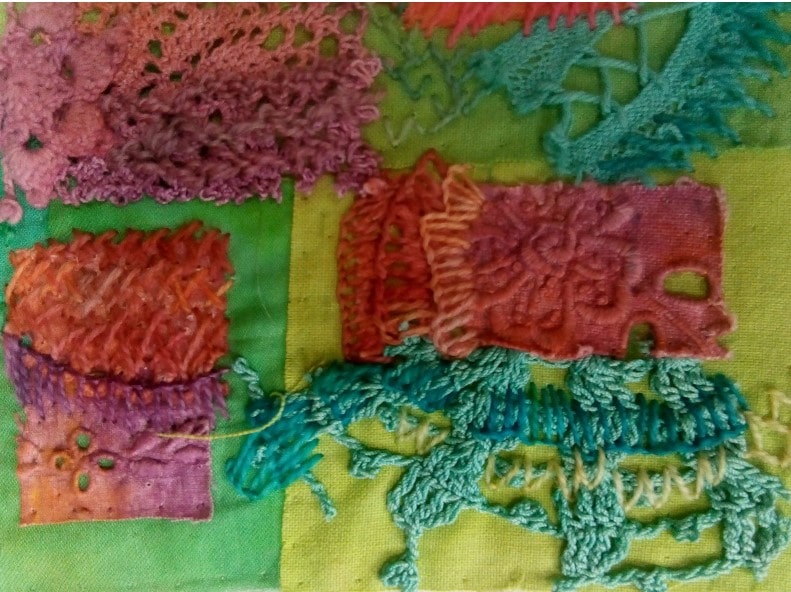


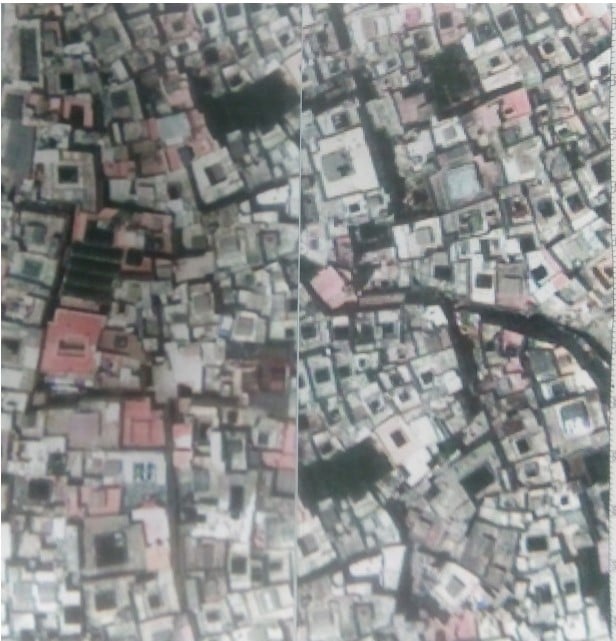


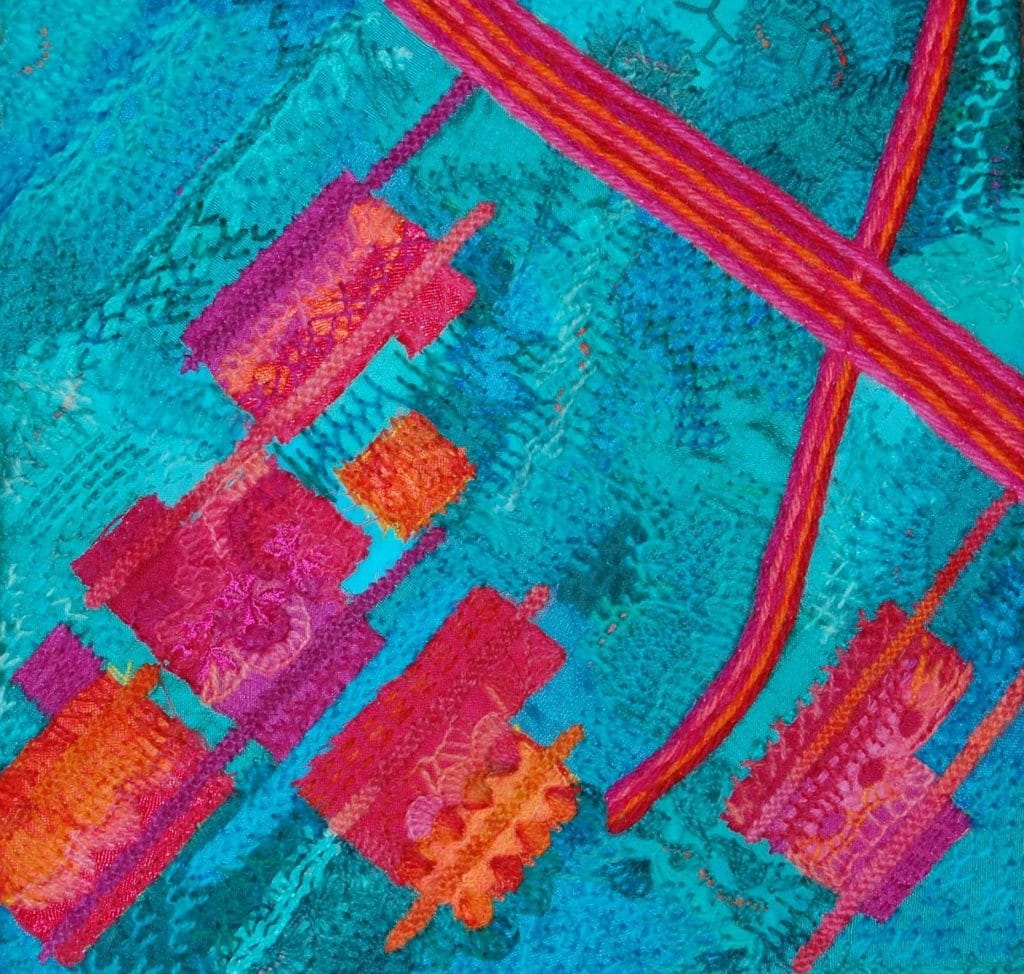
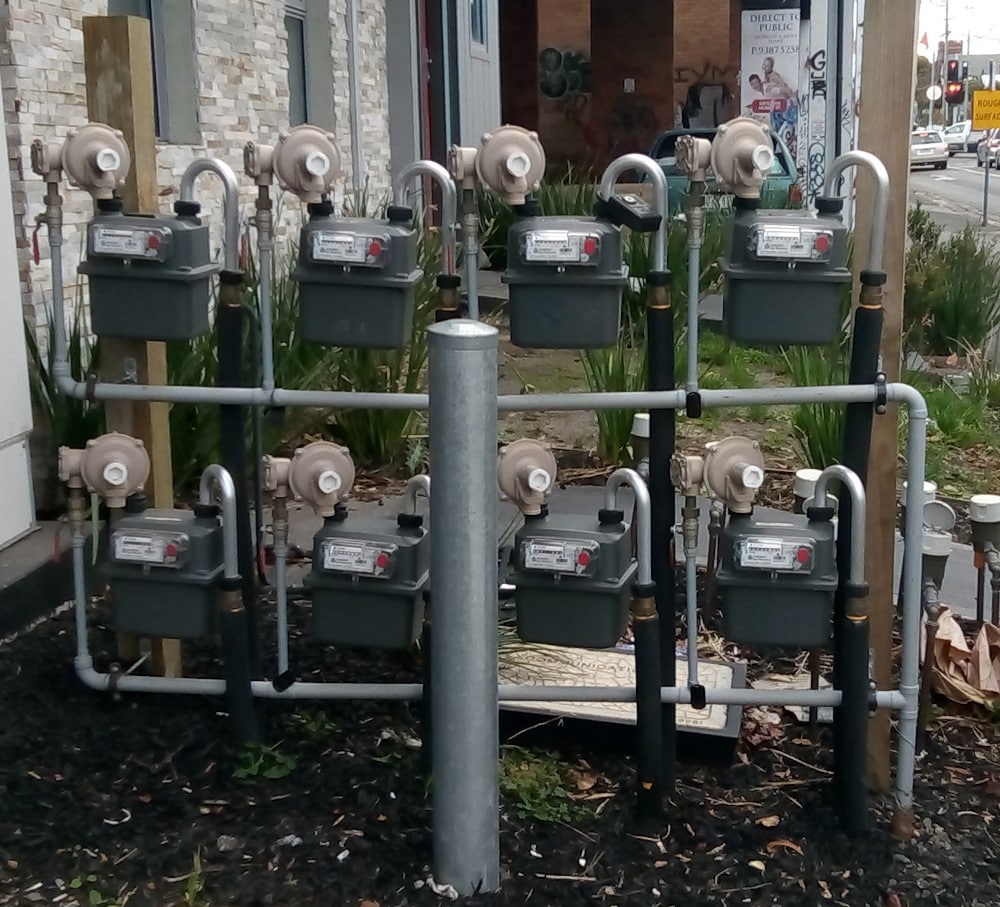
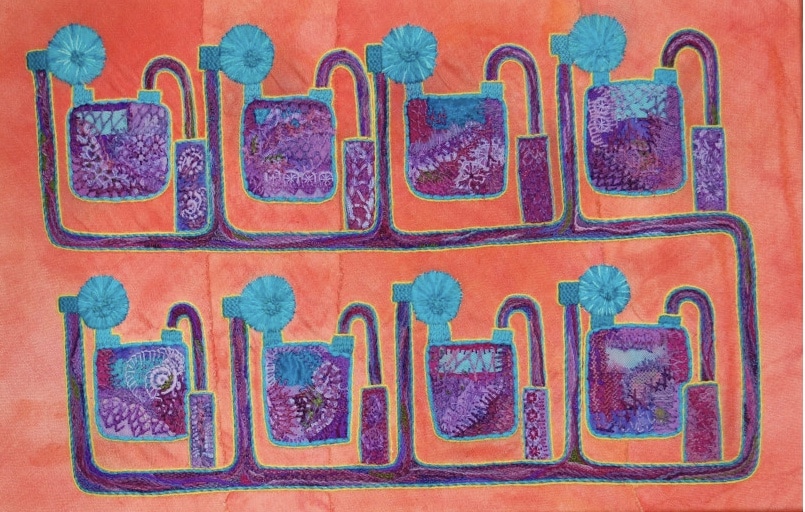
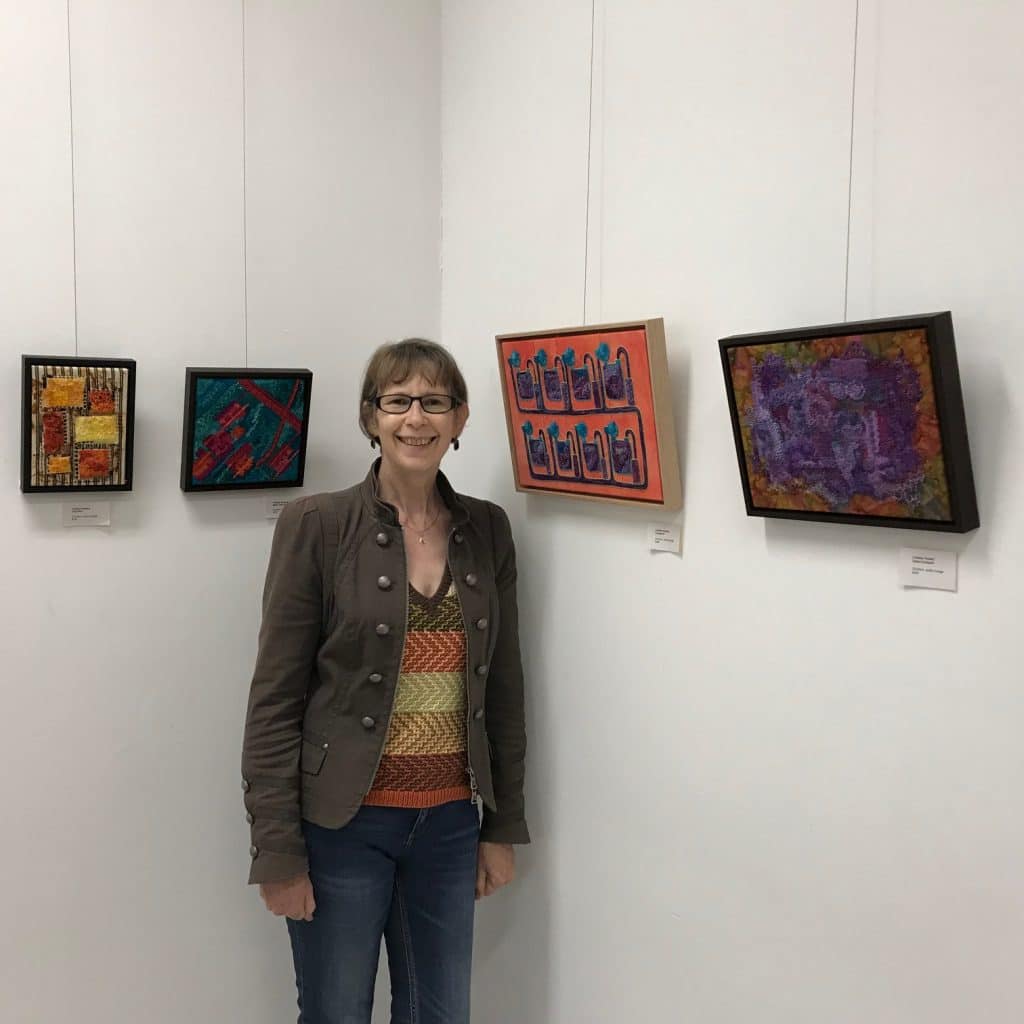

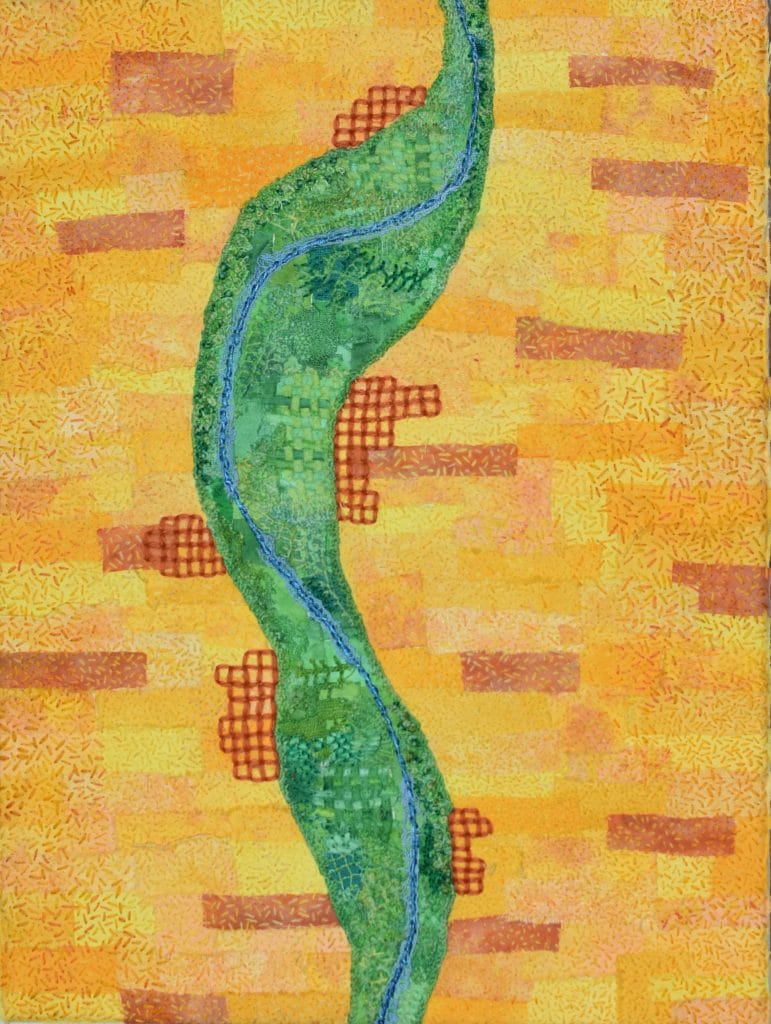

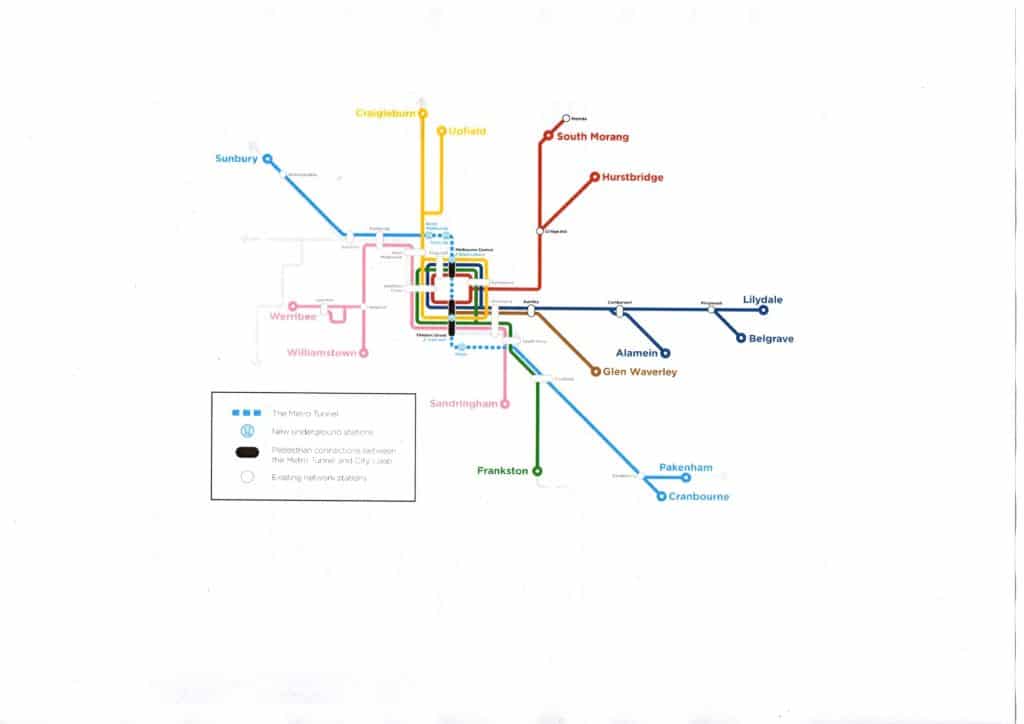

in the Creativity Cluster exhibition De-Construction
/Re-Construction
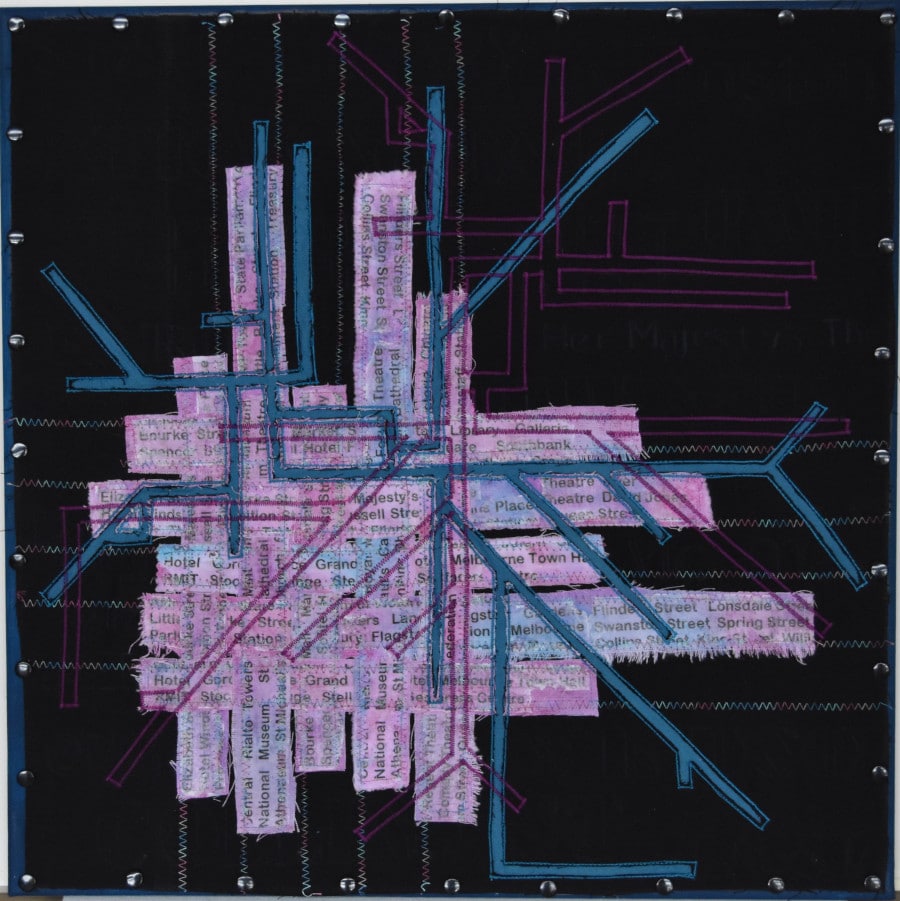
in the Creativity Cluster exhibition De-Construction
/Re-Construction
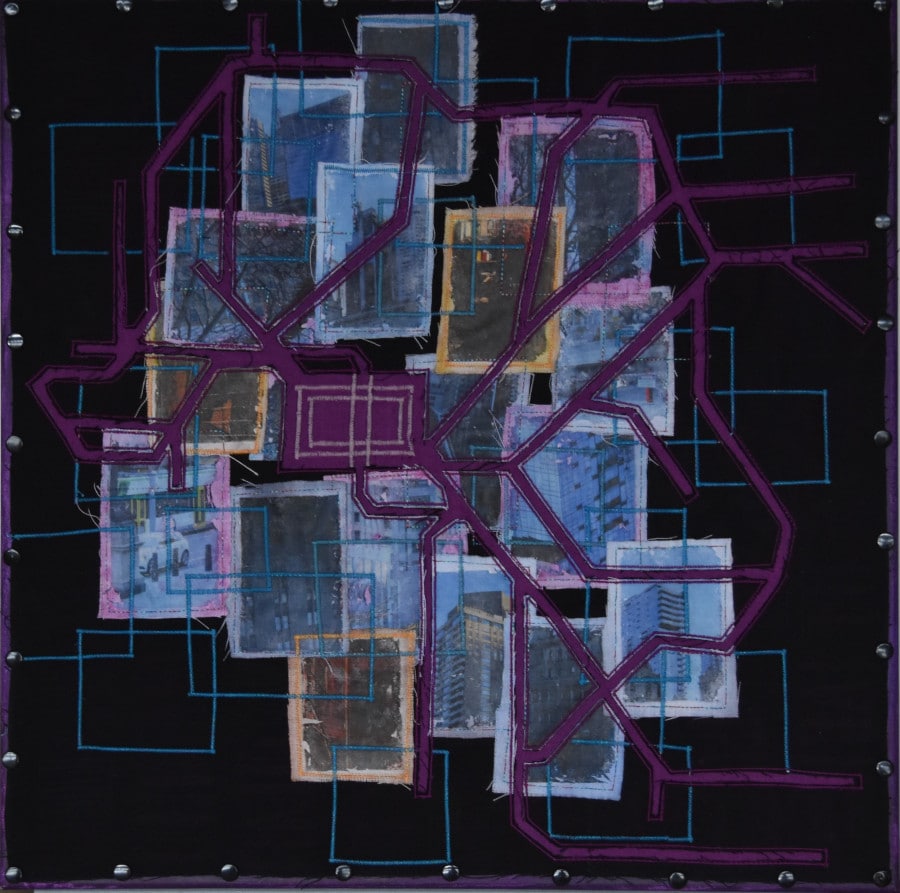
in the Creativity Cluster exhibition De-Construction
/Re-Construction




